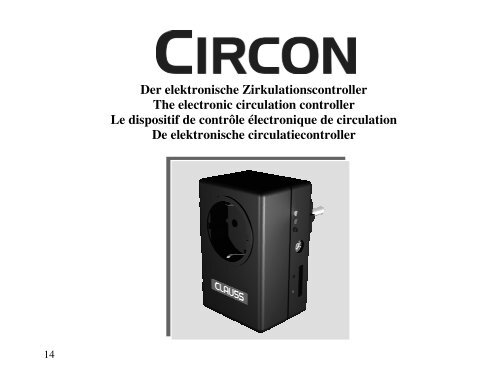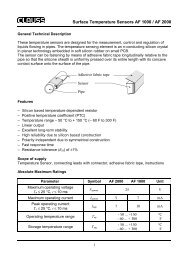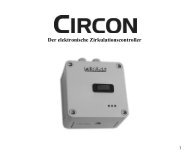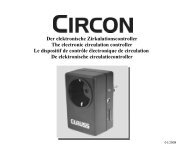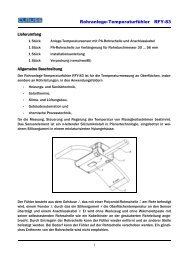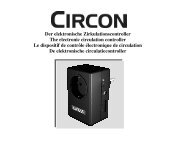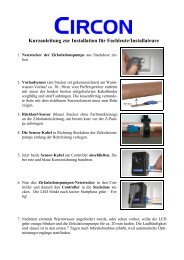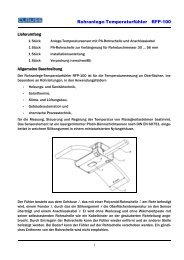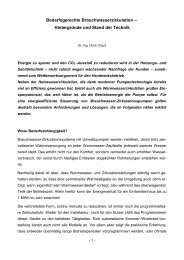Der elektronische Zirkulationscontroller The ... - Circon - dr-clauss
Der elektronische Zirkulationscontroller The ... - Circon - dr-clauss
Der elektronische Zirkulationscontroller The ... - Circon - dr-clauss
You also want an ePaper? Increase the reach of your titles
YUMPU automatically turns print PDFs into web optimized ePapers that Google loves.
14<br />
<strong>Der</strong> <strong>elektronische</strong> <strong>Zirkulationscontroller</strong><br />
<strong>The</strong> electronic circulation controller<br />
Le dispositif de contrôle électronique de circulation<br />
De <strong>elektronische</strong> circulatiecontroller
Sparprogramm/Economy program/Programme économique/Energiebesparend programma:<br />
Position / Positie 0 1 2 3 4<br />
max. Laufzeit / max. running time /<br />
Temps de fonctionnement maximal /<br />
Maximale inschakelduur<br />
5 min 10 min 15 min 20 min 30 min<br />
Automatikprogramm/Automatic program/Programme automatique/Automatisch programma:<br />
Position / Positie 5 6 7 8 9<br />
max. Laufzeit / max. running time /<br />
Temps de fonctionnement maximal /<br />
Maximale inschakelduur<br />
5 min 10 min 15 min 20 min 30 min<br />
Komfortprogramm/Comfort program/Programme de confort/Comfortabel programma:<br />
Position / Positie A B C D E F<br />
Intervall / Interval /<br />
Intervalle / Tussentijd<br />
5 min 10 min 15 min 20 min 30 min 40 min<br />
max. Laufzeit / max. running<br />
time / Temps de<br />
fonctionnement maximal /<br />
Maximale inschakelduur<br />
2 min 5 min 8 min 10 min 15 min 20 min<br />
15
Scope of supply<br />
Basic device with 2 temperature sensors,<br />
Cable fastener,<br />
Operating Manual<br />
Functional description<br />
<strong>The</strong> circulation controller CIRCON is a modern, microcontroller-controlled device for activating the<br />
circulation of hot water in a heating system depending on consumption.<br />
Two temperature sensors monitor the changes in the flow and return temperatures in the circulation circuit.<br />
When water is with<strong>dr</strong>awn from the cooled down circuit, hot water rises from the heat storage tank into the<br />
flow pipe so that the pipe heats up rapidly. <strong>The</strong> temperature rise signals to CIRCON that water has been<br />
with<strong>dr</strong>awn, causing it to start the circulation pump. Thus, just briefly opening a hot-water tap at any point<br />
in the circuit will suffice for initiating circulation. Circulation stops automatically after a predetermined<br />
operating time is reached or after the water in the return pipe has also become sufficiently heated,<br />
whatever occurs earlier. If no return-line sensor has been connected, circulation always is switched off<br />
after the predetermined operating time.<br />
In case of excess temperature of the water in the flow pipe, starting of the circulation pump is prevented.<br />
To avoid the multiplication of Legionella and putrefaction, the circulation pump is automatically activated<br />
once after every 48 hours during periods in which no water has been with<strong>dr</strong>awn.<br />
Controls and indicators<br />
All operating states are signalled via three coloured LEDs:<br />
Flashing light green: Basic device ready for operation, flow and return temperatures are monitored.<br />
Steady light yellow: Circulation pump is on.<br />
Steady light red: Excess temperature in flow pipe.<br />
Flashing light red: Flow-pipe sensor fault (not connected, line interruption or short-circuit)<br />
16
Operating mode selector switch (works setting = 7, operation with screw<strong>dr</strong>iver) (_ page 2):<br />
Economy program:<br />
Function: Circulation starts after water has been with<strong>dr</strong>awn for a short time.<br />
Advantage: Maximum energy saving effect.<br />
Disadvantage: Hot water not immediately available at any time.<br />
Important: Never let the water run until hot water comes out of the tap. Briefly turning on the<br />
hot-water tap for one or a few seconds suffices for activating circulation. After a<br />
certain time, which depends on the flow rate of the water (volumetric delivery of pump),<br />
hot water can be with<strong>dr</strong>awn immediately after the tap is turned on.<br />
Automatic program:<br />
Function: As economy program. In addition, recurrent consumption times are learned and<br />
continually updated.<br />
Advantage: No waiting time required for periodically recurring water consumption patterns. Energy<br />
saving effect is nevertheless high.<br />
Disadvantage: If hot water is needed outside the regular pattern, hot water is not available immediately at<br />
any time.<br />
Comfort program:<br />
Function: As automatic program. Additionally, a cyclic activation function which activates the pump<br />
in certain intervals irrespective of consumption .<br />
Advantage: Depending on the length of the interval, hot water is immediately available at any time.<br />
Disadvantage: Only moderate energy saving effect (will be the higher the longer the intervals are)<br />
17
For an optimum utilisation of the advantage offered by the circulation controller, do not turn on any hotwater<br />
tap unless you do not want to wait for the hot water to come (e.g. if you just wish to briefly wash<br />
your hands). To remind the users of this, the scope of supply also includes stickers.<br />
Installation<br />
18<br />
Important ! Read and observe safety hints before starting the installation !<br />
Selecting the temperature measuring positions<br />
<strong>The</strong> appropriate selection of the installation position and correct attachment of the temperature<br />
sensors is of decisive importance for the proper functioning of the device.<br />
Identifying the appropriate pipes on the hot-water storage tank:<br />
1) All pipes directly connecting the hot-water storage tank to the heating and hot-water boiler or heating<br />
circuit should not come up for closer consideration.<br />
2) Characteristic features of the flow pipe (riser):<br />
- is usually not connected to the top side of the hot-water storage tank<br />
- is not directly connected to the cold-water pipe<br />
- is not fitted with a pump<br />
- in most cases, a three-way mixer valve (thickened T-piece) is installed<br />
3) Characteristic features of the return pipe (circulation line):<br />
- may be connected to the hot-water storage tank from the side or from the top<br />
- has often a smaller cross-section than the flow pipe<br />
- is fitted with the circulation pump<br />
4) To be on the safe side:<br />
- feel the temperature on the pipes coming into question with the circulation pump running<br />
- switch off circulation pump for about 30 min; do not with<strong>dr</strong>aw hot water during this time (the two<br />
pipes of the hot-water circuit will now slowly cool down).
- switch on circulation pump again; now, first the flow pipe and then the return pipe will heat up.<br />
Selecting the measuring position in the flow pipe:<br />
If the sensor is fitted closer to the hot-water storage tank, the water quantity required for activating the<br />
circulation pump will be smaller. However, the temperature changes in the storage tank itself will also<br />
have a greater impact. In particular with continuous copper pipes, it is advisable to position the sensor at a<br />
sufficiently large distance from the tank. If there is a mixer valve in the circuit, install the flow sensor<br />
between the valve and the storage tank. Practical experience has shown that distances to the storage tank<br />
of about 20 to 40 cm are appropriate. With copper pipes, a somewhat greater distance, and with plastic<br />
pipes, a somewhat smaller distance should be chosen.<br />
For systems including different materials, the following applies: Prefer metal to plastics and thin-walled to<br />
thick-walled parts for fitting the sensors.(Further useful hints can be found at www.<strong>dr</strong>-<strong>clauss</strong>.de/circon).<br />
<strong>The</strong> measuring point in the return pipe is not critical, but it should be located as far away as possible from<br />
the hot-water storage tank.<br />
Important: If you have changed the locations at which the sensors have been mounted, you have to<br />
newly start CIRCON. (Pull device out of socket outlet for a few seconds.)<br />
Attaching and connecting the temperature sensors<br />
<strong>The</strong> tender sensor side covered with silicone is the contact surface to the tube. <strong>The</strong> delivered broad cable<br />
ties are used for fixing on the tube, that the sensor in its middle around wind and to lash up well are. If<br />
required, these cable ties can also be opened and they can be employed again. <strong>The</strong> blue connector should<br />
not be mounted by the cable tie.<br />
19
Please mind the following:<br />
♦ cable ties broad sensors only with the corresponding one attach! Employ no narrower cable<br />
ties!<br />
♦ silicone face under no circumstances destroy, contact surface to the tube!<br />
♦ Exercise greatest care when fastening the sensors. Insufficient heat contact with the pipe<br />
may severely affect the proper functioning of the device.<br />
Lay the connecting leads in the direction of the basic device along the pipes or pump connection line so<br />
that persons cannot become caught or trip. Tighten the supplied cable fasteners only slightly so as not to<br />
constrict the cables.<br />
Plug in the two sensor connectors on the side of the circulation controller in accordance with the colour<br />
marking.<br />
red = temperature sensor on flow pipe<br />
blue = temperature sensor on return pipe<br />
Putting into operation<br />
- Set desired operating mode on selector switch.<br />
- Connect sensors.<br />
- Plug mains plug of circulation pump into socket outlet of basic device.<br />
- Plug basic device into 230V/50Hz wall-mounted socket outlet.<br />
Functional test<br />
- Green LED flashes and signals readiness for operation.<br />
- If the hot-water line has already sufficiently cooled down, the pump<br />
must be activated when hot water is with<strong>dr</strong>awn from the circuit at any point in the house (activation is<br />
signalled by the lighting up of the yellow LED). <strong>The</strong> pump must be deactivated on expiry of the<br />
selected running period or prior to this when the temperature of the water in the return pipe has<br />
become sufficiently high.<br />
20
Maintenance<br />
<strong>The</strong> device is completely maintenance-free. Use exclusively a <strong>dr</strong>y cleaning cloth for cleaning. Solvents or<br />
sharp-edged tools must not be used.<br />
Troubleshooting<br />
Fault Possible cause Remedy<br />
• After the pump switches on,<br />
the time it takes till hot water<br />
is available at the various taps<br />
differs, sometimes by many<br />
minutes<br />
• Controller switches off<br />
although hot water has not<br />
yet been supplied to all taps<br />
• Pump switches on during<br />
heating up of the water in the<br />
hot-water storage tank<br />
although no tap has been<br />
turned on<br />
• Fault in the piping system:<br />
No optimum crosssections<br />
in partial circuits<br />
or bypasses exist in the<br />
system<br />
• Pump capacity too low<br />
• Flow sensor arranged too<br />
close to the hot-water<br />
storage tank. Heat contact<br />
to storage tank too close<br />
• Hot-water storage tank<br />
heats up very fast<br />
• Let controller operate<br />
without return sensor:<br />
Switch off pump after a<br />
fixedly set time<br />
• Use pump with a greater<br />
capacity<br />
• Install flow sensor at a<br />
point located farther away<br />
from storage tank<br />
• Do not make any changes<br />
(if no water is with<strong>dr</strong>awn,<br />
the storage tank will also<br />
be heated only infrequently;<br />
an additional circulation<br />
phase is acceptable)<br />
21
22<br />
Fault Possible cause Remedy<br />
tion phase is acceptable)<br />
• Pump switches on after<br />
prolonged standstill without<br />
any noticeable cause<br />
• Pump does not start although<br />
hot water is with<strong>dr</strong>awn from<br />
system<br />
• Pump switches on only after<br />
greater quantities have been<br />
with<strong>dr</strong>awn or does not switch<br />
on at all<br />
• Pump switches on frequently<br />
without any noticeable cause<br />
• Legionella protection<br />
feature has become<br />
activated, or selfcalibration<br />
feature has<br />
tripped<br />
• <strong>The</strong>re is already hot water<br />
in the circuit<br />
• Water in hot-water<br />
storage tank is not or only<br />
slightly heated<br />
• Flow sensor not properly<br />
attached on flow pipe<br />
• Insufficient heat contact<br />
between flow sensor and<br />
pipe<br />
• Draught on sensor<br />
• Sensor has not been fitted<br />
to pipe but to large fittings<br />
which heat up only slowly<br />
• Sensor located too far<br />
away from hot-water<br />
storage tank<br />
• System operates properly<br />
- no changes required<br />
• Controller operates<br />
properly. In this situation,<br />
no cause for starting the<br />
pump exists<br />
• Properly and very<br />
carefully position and<br />
fasten flow sensor (see<br />
installation instructions)<br />
• Provide sensor together<br />
with pipe with heat<br />
insulation<br />
• Select small wall<br />
diameters for fastening
Fault Possible cause Remedy<br />
• No LED display<br />
• Pump does not start although<br />
yellow LED lights<br />
• Pump switches on again<br />
shortly after deactivation<br />
Technical data<br />
• Program run has been<br />
disturbed by short<br />
disturbances in the power<br />
supply grid.<br />
• Defect, e.g. after<br />
overloading<br />
• Deactivation criteria are<br />
already detected in the<br />
hot-water circuit while the<br />
activation criteria are still<br />
active<br />
Mains voltage 230 V AC 50 Hz (own power consumption max. 0.5 W)<br />
Permissible output current max. 1.6 A<br />
Dimensions (LxWxH) 86 mm x 56 mm x 45 mm<br />
Sensor connection leads 2x2.5 m with one connector each<br />
Protective quality to DIN VDE 0701<br />
• Disconnect basic device<br />
for a few seconds from<br />
socket outlet.<br />
• Return device to<br />
manufacturer for repair<br />
• No changes required, the<br />
controller automatically<br />
corrects the erroneous<br />
information<br />
23
24<br />
Safety hints<br />
<strong>The</strong> circulation controller has been shipped from the manufacturer's works in a condition meeting all<br />
safety requirements. To ensure a safe operation, observe the following safety hints. We do not accept any<br />
liability for damage to property or personal injury caused by inappropriate handling and operation or nonobservance<br />
of these safety hints.<br />
Purpose, operating conditions<br />
<strong>The</strong> basic device is exclusively intended, and has been approved only, for use in safety class I (with<br />
earthing contact) 230 V / 50 Hz AC grids in connection with the supplied temperature sensors and a<br />
circulation pump (230 V / max. 1.6 A). <strong>The</strong> circulation controller may not be used on human beings or<br />
animals.<br />
<strong>The</strong> device and its accessories must not be opened, modified or reconstructed. Connecting other devices or<br />
components to the terminals designed for connection to the temperature sensors and circulation pump may<br />
cause personal injury or damage to the basic device or other equipment and is, therefore, not permitted.<br />
<strong>The</strong> device must not be used in damp locations or outdoors or under severe environmental conditions<br />
(moisture or high humidity, dust and flammable gases, vapours or solvents, strong vibrations).<br />
Installation<br />
If the circulation pump is not fitted with a supply lead with fitted mains plug, a qualified electrician will<br />
have to fit this plug. Unqualified persons are not allowed to perform such works.<br />
Install the temperature sensors so that existing devices and piping installations will not be damaged.<br />
Special caution will have to be exercised in the proximity of installed gas lines.<br />
<strong>The</strong> leads for connecting the temperature sensors and the circulation pump shall be laid and fastened so
that they do not cause a tripping hazard or that persons may not get caught.<br />
After a sudden temperature change, e.g. after the device has been transported or stored, allow the device to<br />
acclimatise for at least 15 minutes before putting it into operation.<br />
Operation<br />
Make sure that the enclosure and insulation are neither damaged nor destroyed. <strong>The</strong> circulation controller<br />
must not be covered during operation to allow its own heat to dissipate at all times!<br />
Keep chil<strong>dr</strong>en away from electronic devices operated at mains voltage!<br />
In commercial facilities, the accident prevention regulations issued by the association for electrical<br />
installations and equipment shall be complied with, and the protective quality shall be tested in regular<br />
intervals in accordance with VDE 0701. In schools, training facilities, DIY and self-help workshops,<br />
trained personnel shall be assigned to supervise the operation of power supply units.<br />
Important!<br />
Where there are doubts as to the safe operation of the circulation controller, or where safe operation is no<br />
longer possible, switch off the device immediately and secure it against unintentional operation, in<br />
particular when:<br />
the circulation controller is visibly damaged,<br />
the temperature of the basic device rises excessively, or when it gives off a strong<br />
smell,<br />
malfunctioning of the controller occurs or the controller fails completely.<br />
Under no circumstances may the enclosure be opened or enclosure parts removed!<br />
25
Guarantee<br />
This device is warranted by Dr. Clauß Bild- und Datentechnik GmbH within Germany for a period of 24<br />
months, starting with the date of purchase from a dealer (a note of purchase should be produced as<br />
evidence). Dr. Clauß Bild- und Datentechnik GmbH will rectify during the warranty period free of charge<br />
any faults caused by defective material or workmanship and will at its own discretion repair or replace the<br />
defective part. Replaced parts/devices shall become our property. <strong>The</strong> original warranty period will not be<br />
extended by repairs or replacements. Any work performed by persons not authorised by us will make the<br />
guarantee null and void. This guarantee does not cover any damage caused by improper use, nonobservance<br />
of the operating instructions, tampering by third parties or events of force majeure. We do not<br />
accept any liability for consequential damage resulting therefrom. This warranty does also not cover minor<br />
defects which have only an insignificant impact on the value or serviceability of the device.<br />
Manufacturer: Dr. Clauß Bild- und Datentechnik GmbH<br />
Zwönitzer Gasse 35<br />
D-08297 Zwönitz<br />
www.<strong>dr</strong>-<strong>clauss</strong>.de/circon<br />
Fax:49- 037754 - 507 – 28<br />
eMail: mail@<strong>dr</strong>-<strong>clauss</strong>.de<br />
26


